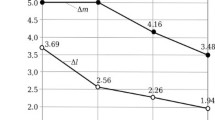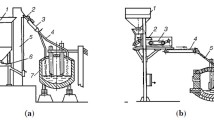This article provides an analysis of the effect of adding hot-briquetted iron (HBI) on the main smelting production indices, DSP-150 lining working layer life, and refractory material consumption for servicing under PAO Tagmet electric steel smelting workshop conditions. Various schemes are considered for HBI charge fractions to a furnace and the optimum version is determined. Changes in slag composition are analyzed with use of HBI. Recommendations are proposed for furnace lining servicing under conditions of using HBI on the example of DSP-150 operated on a solid charge in order to improve its life. The economic saving effect of introducing the recommendations is demonstrated.








Similar content being viewed by others
References
F. R. Grobler and C. A. Minnitt, “The increasing role of direct reduced iron in global steelmaking,” South African Institute of Mining and Metallurgy Journal No. 3, 111 – 116 (1999).
V. I. Trakhimovich and A. G. Shalimov, Use of Direct Reduction of Iron in Steel Smelting [in Russian], Metallurgiya, Moscow (1982).
M. A. Elkader, A. Fathy, M. Eissa, and S. Shama, “Effect of direct reduced iron proportion in metallic charge on technological parameters of EAF steelmaking process,” ISIJ Int., 5(2), 2016 – 2024 (2016).
A. I. Khasan, G. I. Kotel’nikov, A. E. Semin, and G. Megakhed, “Analysis of steel melting technology using metallized pellets and HBI iron in a charge with an increased phosphorus content,” Chernye Metally, No. 5, 64 – 69 (2015).
E. S, Timofeev, “Improvement of energy and technology regime for melting steel in a DSP-150 using hot-briquetted iron in a charge with the aim of increasing production efficiency,” Diss. Cand. Techn. Sci., Moscow (2007).
Ya. Lyukhof, I. Apfel, and I. Buttler, “Use of different forms of metal charge in electric melting production,” Cherny Metally, No. 10, 28 – 33 (2017).
A. A. Korosteliv, G. I. Kotel’nikov, A. E. Semin, et al., “Analysis of the effect of adding hot-briquetted iron to a charge on melting production indices in an electric furnace,” Cherny Metally, No. 10, 33 – 42 (2017).
I. A. Bondarenko, A. K. Turygin, A. L. Artamoshin, et al., “Increase in heating unit lining lidf=fe with use of calcined magnesia lime flux under OAO BMZ conditions,” Lit’ye Metallurgiya, No. 2, 78 – 81 (2013).
A. A. Kozhukhov, A. E. Semin, and G. I. Kotel’nikov, “Study of conditions and factors of foamed slag formation in an arc-melting furnace,” Proc. 13th. Congr. of Steel Smelters (2014).
A. A. babenko, M. V. Ushakov, A. V. Murzin, et al., “Chemical and phase composition of magnesia slags formed in an EAF and their role in slag foaming efficiency,” Proc. 13th. Congr. of Steel Smelters (2014).
J. L. G. Sanchez, A. N. Conejo, and M. A. Ramirez-Argaez, “Effect of foamy slag height on hot spots formation inside the electric arc furnace based on a radiation model,” ISIJ Int., 52(5), 804 – 813 (2012).
I. V. Nekrasov, O. Yu. Sheshukhov, A. A. Metelkin, et al., “Review of research for electric furnace slag regime,” Stal’, No. 6, 28 – 35 (2016).
A. A. Kozhukhov, “Development of scientific bases of steel melting slag foaming with the aim of increasing energy and technology indices of steel production in arc melting furnaces,” Dis. Doc. Techn. Sci., Moscow (2016).
M. V. Zuev, A. A. Babenko, S. P. Burmasov, et al., “Set of production and engineering solutions for reducing energy- and material-content of melting steel semiproduct in contemporary EAF,” Proc. 13th. Congr. of Steel Smelters (2014).
V. O. Krasil’nikov, L. V. Zubakov, M. V. Ushakov, et al., “Advanced technology for operating electric steel smelting furnace lining on the example of DSP-135 of OAO Northern Pipe Plant,” Stal’, No. 6, 31 – 34 (2014).
I. D. Kashcheev, K. K. Strelov, and P. S. Mamykin, Refractory Chemical Technology [in Russian], Intermet Inzhiniring, Moscow (2007).
L. B. Khoroshavin, E. A.. Perepelitsyn and V. A. Kononov, Magnesia Refractories [in Russian], Intermet Inzhiniring, Moscow (2001).
V. S. Starikov, M. V. Temlyantsev, and V. V. Starikov, Refractories and Lining in Ladle Metallurgy [in Russian], MISiS. Moscow (2003).
I. D. Kashcheev, Oxide-Carbon Refractories [in Russian] Intermet Inzhiniring, Moscow (2000).
Author information
Authors and Affiliations
Corresponding author
Additional information
Translated from Novye \Ogneupory, No. 3, pp. 3 – 10, March, 2018.
Rights and permissions
About this article
Cite this article
Korostelev, A.A., S’emshchikov, N.S., Semin, A.E. et al. Increase in EAF Lining Life with Use of Hot-Briquetted Iron in a Charge. Refract Ind Ceram 59, 107–114 (2018). https://doi.org/10.1007/s11148-018-0191-7
Received:
Published:
Issue Date:
DOI: https://doi.org/10.1007/s11148-018-0191-7




